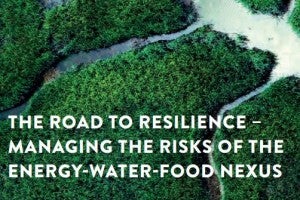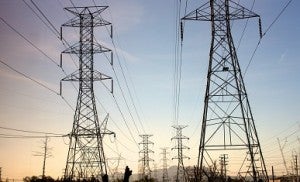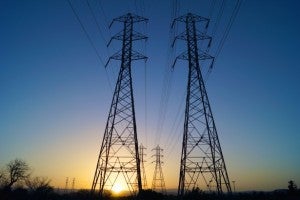 You probably have some sort of insurance – for your healthcare, car, house, or apartment. Acting on climate change is also like insurance. It is all about managing the risks.
You probably have some sort of insurance – for your healthcare, car, house, or apartment. Acting on climate change is also like insurance. It is all about managing the risks.
We can’t know for certain what the future brings, but recent research predicts a 40 percent shortfall of available water across the globe by 2030. In the face of this prediction, a new report from the World Energy Council, “The Road to Resilience – Managing the Risks of the Energy-Water-Food Nexus” helps lay some groundwork to ensure we plan for the climate risks that will affect our most essential resources.
I have talked about the reliance of energy on water and water on energy (the energy-water nexus), and touched on their connection to food. But let me make that linkage clearer: 70 percent of available global freshwater is used by the agricultural sector, and energy is the second-largest freshwater user globally after agriculture (although this varies from country to country and region to region). Relatedly, about 15 percent of total U.S. energy demand is for the food sector (this includes both agriculture and processing), and roughly 13 percent of U.S. energy use is for water-related purposes. Read More










 On vacation and awake in my too-soft bed at 5 AM while my family snored, I was regretting my misaligned sleep schedule. But then I realized time was on my side, so I tiptoed out in solitude for sunrise at the south rim of the Grand Canyon. Thanks to my very clever smart phone that is also a camera, my amateur photos (sort of) reveal the majesty of this national landmark. When we realize the schedule of Nature’s
On vacation and awake in my too-soft bed at 5 AM while my family snored, I was regretting my misaligned sleep schedule. But then I realized time was on my side, so I tiptoed out in solitude for sunrise at the south rim of the Grand Canyon. Thanks to my very clever smart phone that is also a camera, my amateur photos (sort of) reveal the majesty of this national landmark. When we realize the schedule of Nature’s  California has a nice problem: It’s producing so much clean solar energy that the state’s electric grid is at capacity, and sometimes beyond.
California has a nice problem: It’s producing so much clean solar energy that the state’s electric grid is at capacity, and sometimes beyond..jpg) By
By  In extremely disappointing news, the Public Utilities Commission of Ohio (PUCO) recently approved the AEP and FirstEnergy bailout cases. By keeping old, uneconomic coal and nuclear plants running for the next eight years, the bailouts are bad for customers, bad for the environment, and bad for the competitive electric market. Even worse, customers are forced to subsidize these plants, even if they buy their power from a different supplier.
In extremely disappointing news, the Public Utilities Commission of Ohio (PUCO) recently approved the AEP and FirstEnergy bailout cases. By keeping old, uneconomic coal and nuclear plants running for the next eight years, the bailouts are bad for customers, bad for the environment, and bad for the competitive electric market. Even worse, customers are forced to subsidize these plants, even if they buy their power from a different supplier. By:
By: